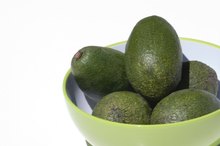What does fact checked mean?
At Healthfully, we strive to deliver objective content that is accurate and up-to-date. Our team periodically reviews articles in order to ensure content quality. The sources cited below consist of evidence from peer-reviewed journals, prominent medical organizations, academic associations, and government data.
- American Dietetic Association; Vegetarian Diets; July 2009
- American Dietetic Association: Eat Right Nutrition Tips
- MayoClinic.com: Nutrition and Healthy Eating
The information contained on this site is for informational purposes only, and should not be used as a substitute for the advice of a professional health care provider. Please check with the appropriate physician regarding health questions and concerns. Although we strive to deliver accurate and up-to-date information, no guarantee to that effect is made.
What Is Nutritional Imbalance & What Forms Are There?
Nutritional imbalance can be caused by an inability of the body to absorb certain nutrients or result from a poor diet. Depending on the nutrients in short or excess supply, imbalances create unpleasant side effects and conditions that could lead to serious disease. You need certain levels of macro- and micronutrients in your daily diet and some foods you don’t need at all. If you follow a special diet, consult a nutritionist or your healthcare provider to be sure you are getting a full complement of healthy nutrients.
Macronutrients
Proteins, carbohydrates and fats are the big three macronutrients. Carbohydrates are your main energy source. MayoClinic.com says 45 to 65 percent of your daily calories should come from carbohydrates. Too few carbs can result in low energy, breakdown of body fat and eventually muscle tissue for fuel, insufficient fiber and constipation and other side effects. Protein is important to every cell and 10 to 35 percent of a balanced diet should be protein. Too much protein can stress the kidneys and the liver and too little protein can cause anemia, poor metabolism, depressed immune system and fluctuating blood sugar levels. A little fat goes a long way. The day’s calories should include no more than 20 to 35 percent from fat. You need fat so your body will absorb nutrients from food and maintain a strong immune system. Too much dietary fat will soon equal too much body fat, with all its attendant health problems.
- Proteins, carbohydrates and fats are the big three macronutrients.
- Too much protein can stress the kidneys and the liver and too little protein can cause anemia, poor metabolism, depressed immune system and fluctuating blood sugar levels.
Micronutrients
What Happens if My Macronutrient Intake Is Insufficient?
Learn More
Imbalances in vitamins, minerals and other micronutrients can cause serious health problems over time. Vitamin A is essential for preventing night blindness and you need the mineral zinc to help your body process vitamin A. Vitamin D, which you can get from exposure to sunlight as well as fish and fortified foods, helps the body to absorb calcium. The University of Maryland Medical Center notes that missing B vitamins affect your ability to turn carbohydrates into energy and to metabolize fats and protein. B vitamins help the nervous system, lower stress, keep your brain sharp and support healthy skin, eyes, hair and liver. Iron is necessary for oxygen-rich blood. Micronutrients are critical for balanced nutrition and dietary sources are best. When a diet doesn’t supply enough of them, supplements can make the difference.
- Imbalances in vitamins, minerals and other micronutrients can cause serious health problems over time.
- B vitamins help the nervous system, lower stress, keep your brain sharp and support healthy skin, eyes, hair and liver.
Vegetarians and Vegans
Vegetarians and vegans could be at risk for nutritional imbalances if they don’t replace animal-based foods with the full spectrum of healthy nutrients. People who do not eat meat, poultry or fish can only get complete proteins from eggs, dairy and soy. Complete proteins synthesize the amino acids that the body cannot produce on its own. Vegans eat no flesh foods at all so their entire diet, excepting soy, includes only incomplete proteins. Eating a broad variety of whole grains, legumes, vegetables, fruits, beans, nuts and seeds will supply adequate protein from combined sources. A varied vegetarian or vegan diet also provides the low-fat, complex carbohydrate-rich foods and the minerals and vitamins for balanced nutrition.
- Vegetarians and vegans could be at risk for nutritional imbalances if they don’t replace animal-based foods with the full spectrum of healthy nutrients.
- People who do not eat meat, poultry or fish can only get complete proteins from eggs, dairy and soy.
Balanced Nutrition Advice
Healthy Diet for a Teenage Boy
Learn More
Eat more vegetables and fruits but skip the fatty or sugary syrups and sauces. The American Dietetic Association says to get protein from lean meats and poultry, omega-3-rich fish such as salmon, nuts, eggs and a mix of plant foods. Forget solid fats and trans fats and stick to unsaturated fats, a modest amount to provide what your body needs without increasing your risk for heart disease and other serious and chronic illnesses. Don’t add salt to your food and you can add years to your heart. Get natural sugar from fruits and sweet vegetables and leave nutrition-poor white flour on the shelf. Whole grains add fiber and nutrients to a balanced diet.
- Eat more vegetables and fruits but skip the fatty or sugary syrups and sauces.
- Forget solid fats and trans fats and stick to unsaturated fats, a modest amount to provide what your body needs without increasing your risk for heart disease and other serious and chronic illnesses.
Related Articles
Writer Bio
Benna Crawford has been a journalist and New York-based writer since 1997. Her work has appeared in USA Today, the San Francisco Chronicle, The New York Times, and in professional journals and trade publications. Crawford has a degree in theater, is a certified Prana Yoga instructor, and writes about fitness, performing and decorative arts, culture, sports, business and education .









